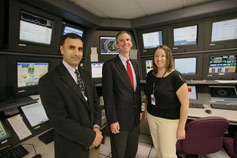

Thursday - May 31, 2007
SLAC Today is
available online at:
http://today.slac.stanford.edu
In this issue:
A
Week of Big Visits
Science Today: Closing in on Dangerous Infections
The Future of Particle (Astro)Physics at SLAC
 |
 |
|
Thursday - May 31, 2007 |
|
From left to right, SLAC's Neil Calder and John Galayda stand with Carlos Sancho
Llerandi and Juan Antonio Rubio.

Hassan Jawahery, Congressman Daniel Lipinski and Stephanie Majewski in the BaBar control
room.
A Week of Big VisitsFor those who want to learn what goes on at SLAC, no amount of reading or sitting through presentations comes anywhere near the experience of visiting the lab. Seeing the installations and absorbing the enthusiasm of SLAC staff always leaves a lasting and positive impression on our visitors. This week, we were privileged to have visits from two distinguished guests. Juan Antonio Rubio, Director General of the Centro De Investigaciones Energeticas, Medioambientales Y Tecnologicas (CIEMAT), spent all day Tuesday touring the lab and meeting with SLAC staff. CIEMAT is a research institute associated with the Spanish Ministry of Science and Technology that aims to improve the use of resources and energy generation systems, to develop alternative energy sources and to solve the problems of the Spanish companies regarding energy and its effects on the environment. Our second visitor was Congressman Daniel Lipinski (D - Illinois), who is the vice chair of the House Science Committee. Congressman Lipinski was particularly interested in research and development for the International Linear Collider and SLAC's successful collaboration with Fermilab. Many thanks to all those who met our guests and helped to make both these visits a real success. |
||
|
|
||
 Closing in on
|
The Future of Particle (Astro)Physics at SLACMark your calendar now—this year's SLAC Users Organization (SLUO) annual meeting will take place on Thursday, June 7. The event is scheduled to coincide with the BaBar collaboration meeting, which begins on June 5. The SLUO meeting will focus on the future of particle physics and particle astrophysics at SLAC, with additional discussions on the future of particle physics in the U.S. as a whole. "Many of SLAC's users want to know what's happening to the lab's particle physics program," said SLUO Chair Frank Porter. "Even nationally, there are a lot of questions about what's going to happen in the years before the International Linear Collider goes online. This year's meeting will address both of these issues, and more." The meeting will include presentations by Jonathan Dorfan, Steven Kahn, Su Dong, John Jaros, Robin Staffin, Joseph Lykken, and Young-Kee Kim. Kim's talk, which will focus on how Fermilab is preparing for the challenges of the field, will be immediately followed by a town hall meeting at 5:20 p.m. in Panofsky Auditorium. All SLUO members are invited to voice their opinions on the future of particle physics and astrophysics at this time. "With PEP-II and BaBar turning off at the end of 2008, there will in some respects be a vacuum in SLAC's particle physics program," said Porter. "This meeting will also offer a time to discuss projects that will continue past 2008, including the ATLAS effort, the particle astrophysics program, and preparation for the International Linear Collider, as well as the Fermilab Roadmap." The agenda is posted at the SLUO website. All are welcome to attend the meeting, which will be held in Panofsky Auditorium from 1:30 until 6:00 p.m. on Thursday, June 7. A reception will follow the town hall meeting at 6:00 p.m. |
Events (see all | submit)
Access (see all)Announcements
|
| | ||
|
|
||
 <%
Response.AddHeader "Last-modified", getArticleDate()
'Response.AddHeader "Last-modified","Mon, 01 Sep 1997 01:03:33 GMT"
'Monday, December 06, 2010
%>
<%
Response.AddHeader "Last-modified", getArticleDate()
'Response.AddHeader "Last-modified","Mon, 01 Sep 1997 01:03:33 GMT"
'Monday, December 06, 2010
%>View online at http://today.slac.stanford.edu/. |
||